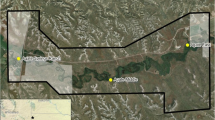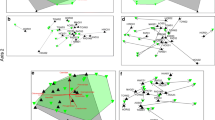Abstract
Activity traps are commonly used to develop abundance indices of aquatic invertebrates and may be deployed with either the funnel parallel to the water surface (horizontal position) or facing down (vertical position). We compared the relative performance of these two positions in terms of numbers of invertebrates captured, species richness of samples, detection rates of specific taxa, and community-level characterizations. Estimates of zooplankton abundance were also compared to quantitative estimates obtained using a watercolumn sampler. We used a matched-pairs design where 10 pairs of traps (one horizontal, one vertical) were deployed in each of 4 prairie wetlands on 5 dates in 1999. Vertical traps had higher detection rates and captured greater numbers of adult and larval Coleoptera, Hemiptera, Chaoboridae, hydracarina, cladocera, and Copepoda and also produced samples with greater species richness. Horizontal traps captured greater numbers of Amphipoda and Ostracoda and had higher detection rates for these taxa. Estimates of zooplankton abundance with vertical traps also correlated better with quantitative estimates and indicated greater differences between wetlands than horizontal traps. Both traps showed similar relationships among wetlands and changes through time at the community level, but vertical traps were more sensitive to temporal change. Our results indicate that vertical traps outperform horizontal traps and are preferable for obtaining indices of invertebrate abundance.
Similar content being viewed by others
Literature Cited
Agresti, A. 1996. An Introduction to Categorical Data Analysis. John Wiley and Sons, New York, NY, USA.
Anderson, J. T. and L. M. Smith. 1996. A comparison of methods for sampling epiphytic and nektonic aquatic invertebrates in playa wetlands. Journal of Freshwater Ecology 11:219–224.
Bouffard, S. H. and M. A. Hanson. 1997. Fish in waterfowl marshes: waterfowl managers’ perspective. Wildlife Society Bulletin 25:146–157.
Brinkman, M. A. and W. G. Duffy. 1996. Evaluation of four wetland aquatic invertebrate samplers and four sample sorting methods. Journal of Freshwater Ecology 11:193–200.
Cheal, F., J. A. Davis, J. E. Growns, J. S. Bradley, and F. H. Whittles. 1993. The influence of sampling method on the classification of wetland macroin vertebrate communities. Hydrobiologia 257:47–56.
Cox, B. B., M. A. Hanson, C. C. Roy, N. H. Euliss, D. H. Johnson, and M. G. Butler. 1998. Growth and survival of mallard ducklings in relation to aquatic invertebrates. Journal of Wildlife Management 62:124–133.
Euliss, N. H., D. A. Wrubleski and D. M. Mushet. 1999. Wetlands of the prairie pothole region: invertebrate species composition, ecology, and management. p. 471–514. In D. P. Batzer, R. P. Rader, and S. A. Wissinger (eds.) Invertebrates in Freshwater Wetlands of North America: Ecology and Management. John Wiley, New York, NY, USA.
Hanson, M. A. and M. R. Riggs. 1995. Effects of fish predation on wetland invertebrates: a comparison of wetlands with and without fathead minnows. Wetlands 15:167–175.
Hanson, M. A., C. C. Roy, N. H. Euliss, K. D. Zimmer, and M. G. Butler. 2000. A surface-associated activity trap for capturing water-surface and aquatic invertebrates in wetlands. Wetlands 20:205–212.
Kaminski, R. M. and H. R. Murkin. 1981. Evaluation of two devices for sampling nektonic invertebrates. Journal of Wildlife Management 45:493–496.
Keene, O. N. 1995. The log transformation is special. Statistics in Medicine 14:811–819.
Littell, R. C., G. A. Milliken, W. W. Stroup, and R. C. Wolfinger. 1996. SAS System for Mixed Models. SAS Institute Inc., Cary, NC, USA.
Murkin, H. R. and D. A. Wrubleski. 1988. Aquatic invertebrates of freshwater wetlands: function and ecology. p. 239–249. In D. D. Hook, W. H. Mckee, H. K. Smith, J. Gregory, V. G. Burrell, M. R. Devoe, R. E. Sojka, S. Gilbert, R. Banks, L. H. Stolzy, C. Brooks, T. D. Matthews, and T. H. Shear (eds.) The Ecology and Management of Wetlands. Volume 1: Ecology of Wetlands. Croom Helm, London, England.
Murkin, H. R., P. G. Abbott, and J. A. Kadlec. 1983. A comparison of activity traps and sweep nets for sampling nektonic invertebrates in wetlands. Freshwater Invertebrate Biology 2:99–106.
Rice, W. R. 1990. A consensus combined P-value test and the family-wide significance of component tests. Biometrics 46:303–308.
SAS (Statistical Analysis Systems). 1990a. SAS/STAT User’s Guide, volume 1, fourth edition. SAS Institute, Cary, NC, USA.
SAS (Statistical Analysis Systems). 1990b. SAS/STAT User’s Guide, volume 2, fourth edition. SAS Institute, Cary, NC, USA.
Swanson, G. A. 1978. Funnel trap for collecting littoral macroinvertebrates. Progressive Fish-Culturist 40:73.
ter Braak, C. J. F. 1995. Ordination. p. 91–173. In R. H. G. Jongman, C. J. F. ter Braak, and O. F. R. van Tongeren (eds.) Data analysis in community and landscape ecology. Cambridge University Press, Cambridge, England.
ter Braak, C. J. F. and P. Smilauer. 1998. CANOCO Reference Manual and User’s Guide to Canoco for Windows: Software for Canonical Community Ordination, Version 4. Microcomputer Power. Ithaca, NY, USA.
Turner, A. M. and J. C. Trexler. 1997. Sampling aquatic invertebrates from marshes: evaluating the options. Journal of the North American Benthological Society 16:694–709.
von Tongeren, O. F. R. 1995. Cluster analysis. p. 174–212. In R. H. G. Jongman, C. J. F. ter Braak, and O. F. R. van Tongeren (eds.) Data Analysis in Community and Landscape Ecology. Cambridge University Press, Cambridge, England.
Zimmer, K. D., M. A. Hanson, and M. G. Butler. 2000. Factors influencing invertebrate communities in prairie wetlands: a multivariate approach. Canadian Journal of Fisheries and Aquatic Sciences 57:76–85.
Author information
Authors and Affiliations
Rights and permissions
About this article
Cite this article
Muscha, M.J., Zimmer, K.D., Butler, M.G. et al. A comparison of horizontally and vertically deployed aquatic invertebrate activity traps. Wetlands 21, 301–307 (2001). https://doi.org/10.1672/0277-5212(2001)021[0301:ACOHAV]2.0.CO;2
Received:
Revised:
Accepted:
Issue Date:
DOI: https://doi.org/10.1672/0277-5212(2001)021[0301:ACOHAV]2.0.CO;2




